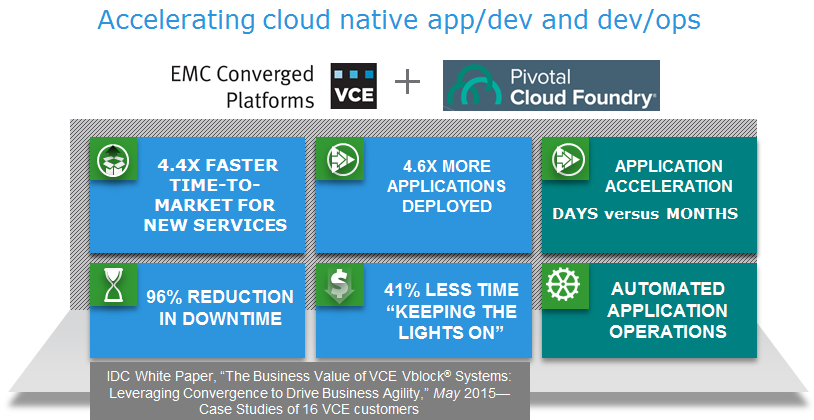You have probably heard that “cloud native” is a whole new way of developing web and mobile applications. It is taking over the world. The business rationale is pretty straightforward. Create new applications and releases in days or weeks instead of months. Do new releases as often as every day, or multiple times a day. Build robust applications quickly using microservices and run your workloads within containers (think Docker) that are equipped to run on any cloud—public or private, and on any type of infrastructure. In order to innovate fast enough to stay competitive, all sizes and types of organizations are heading down the cloud native path.
The open source Cloud Foundry platform-as-a-service capability is at the center of the move to cloud native. Cloud Foundry is supported by more than 50 leading companies including IBM, HP, EMC, VMware, Pivotal, SAP, Verizon, Allstate, CenturyLink, Capgemini, and Accenture. Pivotal, an EMC Federation company, offers the leading commercial version, Pivotal Cloud Foundry (PCF). The “Foundation for Pivotal Cloud Foundry”, incorporates factory installation and on-site integration of Pivotal Cloud Foundry software on Vblock 340, Vblock 540, or VxRack 1000. VCE and EMC are developing new cloud native solutions, so expect additional announcements through 2016.
But what is the point of using converged infrastructure if cloud native apps are designed to run on any infrastructure? The answers, again, are pretty straight-forward. Time-to-market through fast provisioning of resources for developers and operations teams. Fast, easy scalability. The security, compliance, and governance advantages of private cloud. The substantial cost advantages of private cloud for enterprise-scale, compliant infrastructure and 24/7/365 applications (e.g. most large company mission-critical web and mobile applications). And yes, resilience, because even if cloud native approaches can build resilience into the application, why not put business-critical web and mobile applications on infrastructure that has a great track-record for reliability.
According to IDC’s survey summary, Vblock users achieved the following advantages versus customers’ previous DIY infrastructure: 4.4X faster time to market for new services, 4.6X more applications deployed, a 96% reduction in downtime, and 41% less time “keeping the lights on”. These converged infrastructure benefits directly amplify cloud native application development and DevOps: get more applications to market faster, with higher resilience, while freeing up staff resources to accelerate innovation. Cloud native Pivotal Cloud Foundry installed on VCE converged infrastructure is a 1 + 1 = 3 value proposition.

OK, but what is the advantage of Pivotal Cloud Foundry? Aren’t there some pretty great and popular open source tools out there for cloud native development and operations (Docker, Spring, Jenkins, and Bosh to name just a few)? These tools are great and they are gaining rapid adoption. However, successful cloud native application development and DevOps involves a highly structured process that requires tight integration across a whole array of open source tools. If you buy all of these great cloud- native tools separately you can end up with an unstructured platform that is complex, difficult to integrate, and hard to maintain. The buy versus build rationale for PaaS is similar to the rationale for converged infrastructure. Why spend your time and resources building (acquiring, assembling, and maintaining multiple software tools) when you can buy a structured PaaS, Pivotal Cloud Foundry, that integrates the tools. Highly structured cloud native processes have a greater chance for success on a structured, integrated platform. Does that sound logical? Pivotal Cloud Foundry also integrates tightly with the VMware vSphere capabilities on VCE infrastructure.
Going cloud native is not just about acquiring great new technology. It is a dramatically different way to develop and deploy. For those companies that desire a way to accelerate results on the cloud native journey, Pivotal staff can work side by side (quite literally) with your teams to build your first cloud native applications, transfer knowledge, and help to build the new processes required for cloud native success. Pivotal’s 1,800 member staff in 16 global offices includes engineers and developers who have helped more than 1,000 organizations, of all sizes and types in all geographies and industries, to realize the benefits of cloud native transformation.
Your organization rocks when you can innovate fast enough to beat your competition. That’s a big deal.